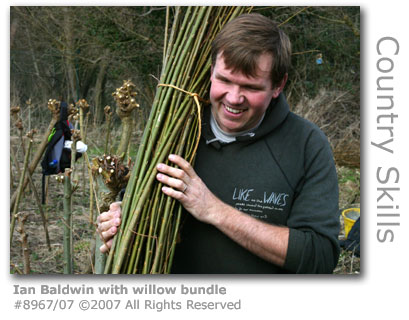
 |
HOME |
Cultivating Your Own Withybeds Ian Baldwin is a leading proponent in encouraging local people to take an interest in the natural resources of the Valley, and to become involved in country skills. Here he explains how to establish your own withybed for the cultivation of willow stems that can be used for weaving baskets, furniture and has other practical uses in the countryside. |
|
 |
||
|
DIY Withybeds Well we all need a spot of willow from time to time for some form of garden furniture weaving, fencing panels, basket weaving, riverbank stabilizing, or even using as an excellent hazel substitute for hedgelaying binders. But we all know that you have to go to Somerset to get the best material, where it’s grown by the field, harvested by machine and sold by mail order if you only need a few bundles. Locally, there are a few biomass crop experiments which individual entrepreneurs have taken over, but generally there are no withybeds remaining in Surrey, or rather there weren’t until a few years ago, 1999, when I decided to reverse the trend. A Godalming riverside meadow, a local gardener, a handy supply of willow and a basket-making course all conspired to weave their magic (pun intended) on me. The first year involved a spot of cropping whatever looked vaguely straight, but planting a few too, to see which varieties would take best, and to guarantee a better crop the following year. The Recipe First, take a wet patch of ground. It needn’t be large, and could just involve a wet ditch, pond edge, spoil heap, edge of a manure pile, whatever. Anywhere where there is a piece of wet, nutrient-rich ground, usually the sort of place which is fairly useless for other “crops”. Under electricity pylons is another useful spot. Gently sprinkle with however many willows you can get your hands on, by selecting those varieties which already grow straight and unforked, and using the tips of such trees, rich in natural growth hormones (auxins). Plunge each planter into the ground as deep as you dare (18 inches to two feet is good going) and prune to 4 feet high, to prevent Bambi, Thumper and their friends from ruining your plans. Place into as much sunshine as the British climate will spare and leave well alone until the leaves have fallen (November onwards). Crop, add more planters and repeat. The Result Three years on, a few lessons learnt and patience is starting to pay dividends. I have now started to plant new withybeds from this original one, and expect that this winter will start to yield a few thousand planters / binders, as well as plenty of panel and basket-making material. Cropping at 4 feet high has advantages for those with bad backs, and enables cropping in areas currently dominated by nettles or other rank vegetation. So, no more trips to Somerset for me, much less trimming of hazels that are almost binder quality and more crop from the same area every winter. So look out Somerset – you’ve got competition! For more details, feel free to contact Ian Baldwin on © Wey River 2005 - 2007 : All rights reserved |